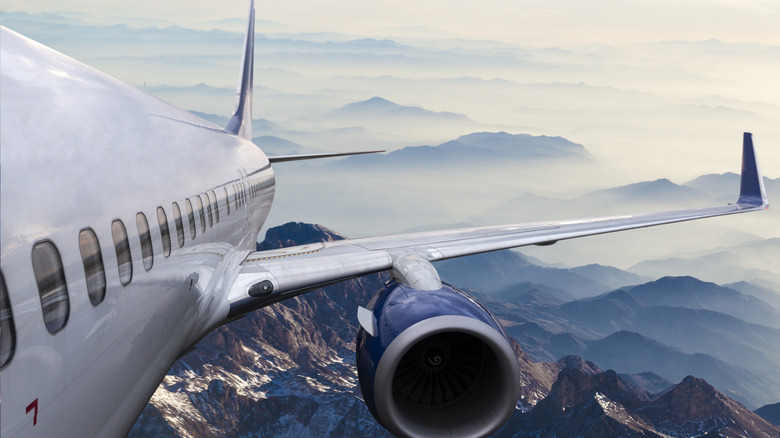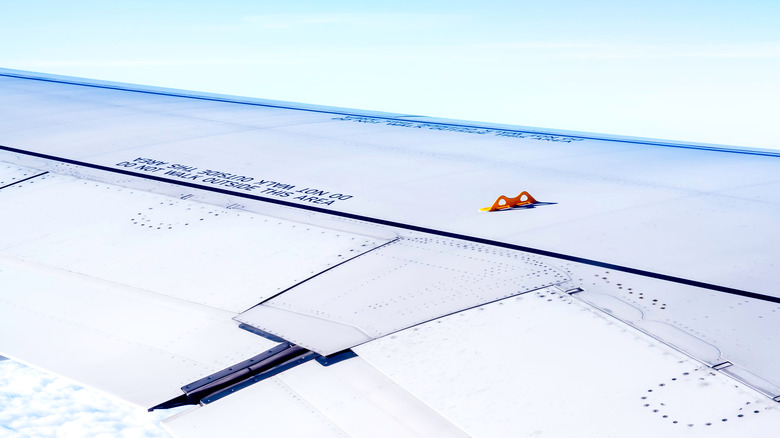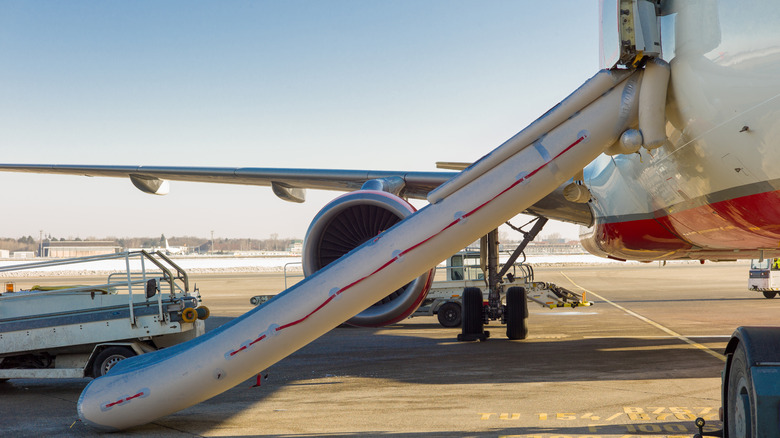The Unsettling Reason For This Odd Plane Feature You May Have Never Even Noticed
Many fliers' biggest fear is being buckled in while their flight crashes or makes an emergency landing. Thankfully, these incidents are rare — global statistics are hard to pinpoint, but WCNC Charlotte reported that one emergency landing took place per 1,600 landings at Charlotte Douglas International Airport. Even fewer flights result in fatal crashes (1 in 11 million annual risk), according to research by David Ropeik, an Instructor in Risk Communication at the Harvard School of Public Health.
Still, in-flight failures can never be completely ruled out, which is why aircraft designers and engineers outfit planes with some hidden features meant to save your life. One such feature: a tiny yellow hook on the wings. If you look closely from the cabin window during your next flight, you might notice the small contraption with two holes protruding from the top of each wing. It might not look like much, but according to pilot and YouTuber Captain Joe, the yellow hook plays a crucial role in many successful emergency evacuations.
The hook can save your life during an emergency
If you've ever sat in an exit row seat on an airplane, you know that, if things go awry, you might be tasked with opening the exit to help save your fellow passengers. But what happens after you open the emergency hatch? Captain Joe explains that on most planes, opening the exit triggers the escape slide and a rope to eject near the wing. The slide will quickly inflate so passengers can make their way to safety.
However, as Captain Joe notes, if you try to step onto the wing from the emergency exit door, you might slip and fall — which could be disastrous if, for example, the evacuation takes place on water or the aircraft is on fire. But this is where that little yellow hook comes into the picture. The rope that was deployed along with the slide must be fastened to the hook through one hole and tethered to the slide through the other hole. Then, passengers can hold onto the rope to maintain their balance on the wing. During an emergency landing on water, life rafts can also be secured to the hooks so they don't float away.
If it sounds a little complicated, know that a flight attendant should be available to explain the process, particularly if you're seated near one of the emergency exits. And if you don't see the hook at all, don't worry. Planes without an overwing slide don't use the same hook-and-rope system.
Other tips to know when making an emergency escape
Hopefully, you won't ever need to use an airplane's emergency evacuation slide. But in case disaster strikes and you need to get out quickly, it helps to be familiar with the procedure before it's needed. First, always pay attention to the safety briefings at the beginning of your flight and read the safety manual provided at your seat. You should also spot your nearest emergency exit, which may be behind you.
Once the flight crew announces that an emergency evacuation will take place, promptly stow away your belongings (dropping them to the floor could block or trip other passengers) and remove high heels or anything pointy that could puncture the escape slide. Then, make your way to your designated exit, making sure to follow any instructions given by your flight attendants. If the cabin is dark or smoky, follow the lights on the floor.
When you get to the slide, be quick and decisive. There will often be two lanes, so pick one and let the person behind you move to the other. If possible, don't sit before sliding down. Simply cross your arms over your chest and jump feet first down the slide. Once you've made it to the bottom, swiftly move away to make room for other passengers.


